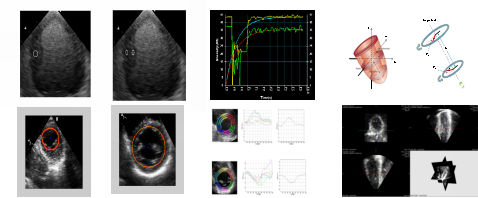
Heart failure is the leading cause of death in patients with coronary heart disease, high blood pressure, congenital heart disease and other cardiovascular diseases. Early quantitative evaluation of cardiac function for high-risk population and early effective intervention are helpful to prolong the life of patients and improve the prognosis. 2D/3D speckle tracking echocardiography (2D/3D STE) is a new ultrasound imaging technology, which can quantitatively assess overall and regional myocardial function, and ventricular systolic and diastolic function. So 2D/3D STE is capable of providing the quantitative analysis of cardiac function, also is kind of the technical means for study of the biological elastic properties of myocardium.
We have studied advanced echocardiography image processing methods for years in order to realize 2D/3D STE imaging technology autonomously, including velocity vector imaging, strain and strain rate imaging, and quantitative analysis and imaging of left ventricular torsion(e.g, (a) Numerical Methods and Workstation for the Quantitative Analysis of Real-Time Myocardial Contrast Echocardiography, IEEE Transactions on Information Technology in Biomedicine. 2010, 14(5): 1204-1210; (b) Region of Interest Tracking in Real-Time Myocardial Contrast Echocardiography, Journal of Medical Systems. 2011, 35(2): 163-167; (c) Measurement of Left Ventricular Torsion Using Block-matching-based Speckle Tracking for Two-dimensional Echocardiography, Journal of Electronic Imaging. 2013, 22(1): 0130101-0130105; (d) Numerical Simulation of Strain and Strain Rate Analysis in Two-dimensional Speckle Tracking Echocardiography (in Chinese),Space Medicine & Medical Engineering,2016; (e) Cardiac cycle estimation of echocardiography with speckle tracking (in Chinese),Journal of Shandong University(Engineering Science),2017). Achievements of our work will improve the clinical diagnosis of cardiovascular diseases.Now, wearedeveloping some software packages for clinical applications andlooking for cooperation withtheindustry towardsthecommercialization.